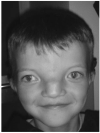Donnai-Barrow syndrome (DBS/FOAR) in a child with a homozygous LRP2 mutation due to complete chromosome 2 paternal isodisomy
- PMID: 18553518
- PMCID: PMC2891749
- DOI: 10.1002/ajmg.a.32381
Donnai-Barrow syndrome (DBS/FOAR) in a child with a homozygous LRP2 mutation due to complete chromosome 2 paternal isodisomy
Abstract
Donnai-Barrow syndrome [Faciooculoacousticorenal (FOAR) syndrome; DBS/FOAR] is a rare autosomal recessive disorder resulting from mutations in the LRP2 gene located on chromosome 2q31.1. We report a unique DBS/FOAR patient homozygous for a 4-bp LRP2 deletion secondary to paternal uniparental isodisomy for chromosome 2. The propositus inherited the mutation from his heterozygous carrier father, whereas the mother carried only wild-type LRP2 alleles. This is the first case of DBS/FOAR resulting from uniparental disomy (UPD) and the fourth published case of any paternal UPD 2 ascertained through unmasking of an autosomal recessive disorder. The absence of clinical symptoms above and beyond the classical phenotype in this and the other disorders suggests that paternal chromosome 2 is unlikely to contain imprinted genes notably affecting either growth or development. This report highlights the importance of parental genotyping in order to give accurate genetic counseling for autosomal recessive disorders.
2008 Wiley-Liss, Inc.
Figures



Similar articles
-
The distinct optic disk and peripapillary appearance in Donnai-Barrow syndrome.Ophthalmic Genet. 2018 Jun;39(3):321-324. doi: 10.1080/13816810.2018.1430245. Epub 2018 Feb 1. Ophthalmic Genet. 2018. PMID: 29388841
-
Broadening the phenotype of LRP2 mutations: a new mutation in LRP2 causes a predominantly ocular phenotype suggestive of Stickler syndrome.Clin Genet. 2014 Sep;86(3):282-6. doi: 10.1111/cge.12265. Epub 2013 Sep 23. Clin Genet. 2014. PMID: 23992033
-
Variable expression pattern in Donnai-Barrow syndrome: Report of two novel LRP2 mutations and review of the literature.Eur J Med Genet. 2015 May;58(5):293-9. doi: 10.1016/j.ejmg.2014.12.008. Epub 2015 Feb 13. Eur J Med Genet. 2015. PMID: 25682901 Review.
-
A prenatally diagnosed case of Donnai-Barrow syndrome: Highlighting the importance of whole exome sequencing in cases of consanguinity.Am J Med Genet A. 2020 Feb;182(2):289-292. doi: 10.1002/ajmg.a.61428. Epub 2019 Dec 10. Am J Med Genet A. 2020. PMID: 31821692
-
A review of Donnai-Barrow and facio-oculo-acoustico-renal (DB/FOAR) syndrome: clinical features and differential diagnosis.Birth Defects Res A Clin Mol Teratol. 2009 Jan;85(1):76-81. doi: 10.1002/bdra.20534. Birth Defects Res A Clin Mol Teratol. 2009. PMID: 19089858 Free PMC article. Review.
Cited by
-
Genome-wide significance testing of variation from single case exomes.Nat Genet. 2016 Dec;48(12):1455-1461. doi: 10.1038/ng.3697. Epub 2016 Oct 24. Nat Genet. 2016. PMID: 27776118 Free PMC article.
-
Whole exome sequencing in a patient with uniparental disomy of chromosome 2 and a complex phenotype.Clin Genet. 2013 Sep;84(3):213-22. doi: 10.1111/cge.12064. Epub 2012 Dec 20. Clin Genet. 2013. PMID: 23167750 Free PMC article. Review.
-
Maternal Uniparental Isodisomy of Chromosome 2 Leading to Homozygous Variants in SPR and ZNF142 : A Case Report and Review of the UPD2 Literature.Glob Med Genet. 2024 Mar 26;11(1):100-112. doi: 10.1055/s-0044-1785442. eCollection 2024 Jan. Glob Med Genet. 2024. PMID: 38533443 Free PMC article. Review.
-
Genetic aspects of human congenital diaphragmatic hernia.Clin Genet. 2008 Jul;74(1):1-15. doi: 10.1111/j.1399-0004.2008.01031.x. Epub 2008 May 28. Clin Genet. 2008. PMID: 18510546 Free PMC article. Review.
-
Two novel variations in LRP2 cause Donnai-Barrow syndrome in a Chinese family with severe early-onset high myopia.Front Genet. 2023 Jan 27;14:1107347. doi: 10.3389/fgene.2023.1107347. eCollection 2023. Front Genet. 2023. PMID: 36777721 Free PMC article.
References
-
- Bakker B, Bikker H, Hennekam RC, Lommen EJ, Schipper MG, Vulsma T, de Vijlder JJ. Maternal isodisomy for chromosome 2p causing severe congenital hypothyroidism. J Clin Endocrinol Metab. 2001;86:1164–1168. - PubMed
-
- Chavez B, Valdez E, Vilchis F. Uniparental disomy in steroid 5alpha-reductase 2 deficiency. J Clin Endocrinol Metab. 2000;85:3147–3150. - PubMed
-
- Donnai D, Barrow M. Diaphragmatic hernia, exomphalos, absent corpus callosum, hypertelorism, myopia, and sensorineural deafness: A newly recognized autosomal recessive disorder? Am J Med Genet. 1993;47:679–682. - PubMed
-
- Engel E. A new genetic concept: Uniparental disomy and its potential effect, isodisomy. Am J Med Genet. 1980;6:137–143. - PubMed
-
- Engel E. A fascination with chromosome rescue in uniparental disomy: Mendelian recessive outlaws and imprinting copyrights infringements. Eur J Hum Genet. 2006;14:1158–1169. - PubMed
Publication types
MeSH terms
Substances
Grants and funding
LinkOut - more resources
Full Text Sources
Medical

